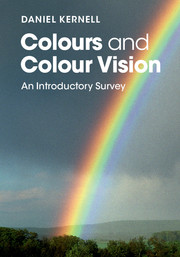Book contents
- Frontmatter
- Dedication
- Contents
- List of plates
- List of figures
- List of tables
- Preface
- 1 Colour vision in everyday life
- 2 The signals of colours: light and wavelengths
- 3 Colours and viewing conditions: not only local wavelengths
- 4 Our biological hardware: eye and brain
- 5 Eyes with unconventional properties: the ‘red-green blinds’
- 6 Other kinds of unconventional colour vision
- 7 Colour vision in different species of animals
- Appendices
- Notes
- References
- Index
- Plate section
5 - Eyes with unconventional properties: the ‘red-green blinds’
Published online by Cambridge University Press: 05 March 2016
- Frontmatter
- Dedication
- Contents
- List of plates
- List of figures
- List of tables
- Preface
- 1 Colour vision in everyday life
- 2 The signals of colours: light and wavelengths
- 3 Colours and viewing conditions: not only local wavelengths
- 4 Our biological hardware: eye and brain
- 5 Eyes with unconventional properties: the ‘red-green blinds’
- 6 Other kinds of unconventional colour vision
- 7 Colour vision in different species of animals
- Appendices
- Notes
- References
- Index
- Plate section
Summary
Plate 5.1 shows a number of coloured dots. For people with normal colour vision, some of the dots form the digit ‘6’, which may be seen thanks to the colour difference between these dots and the surrounding ones. However, for about 8% of all European men and and about 0.4% of the women these dots have about the same colour as many of the other ones and no numbers are seen. This picture is taken from a sensitive test for the identification of defective colour vision.
People with a deviant kind of colour vision are usually called ‘colour blind’, and in this chapter I will describe the most common type of this deviation, the inborn so-called ‘red-green blindness’, a visual constitution which is often diagnosed with test pictures like Plate 5.1. The terminology used for these varieties of colour vision is unfortunate and often leads to misunderstandings: only a very few of the so-called ‘colour-blind’ individuals are actually seeing the world without colour (Chapter 6), and this is certainly not the case for red-green blind people. Such persons see most or all of the reddish or greeinsh hues as chromatic colour, i.e. they are actually not at all ‘red-green blind’; they do, however, have difficulties in distinguishing many of the red-green hues and nuances from each other, a property that might be labelled colour uncertainty or colour ambivalence rather than colour blindness. Unfortunately, the terms ‘colour blindness’ and ‘red-green blindness’ are so firmly established that I feel forced to use them also in this book. However, it should be stressed at the outset that, as I see it, red-green blindness should not to be regarded as a disease, but rather as one of the many ways in which people might differ from each other in their inborn constitution.
John Dalton and his brother
In the world of a couple of hundred years ago, there were few (if any) colour-coded signals and the colours perceived were then a rather personal and introspective affair: people were not yet required to react to particular colours in rapid and highly specific manners. For such reasons, it took humanity a surprisingly long time to discover that people differed in their ability to detect and identify colour differences. One of the first investigators in this field was the prominent English physicist/chemist John Dalton (Figure 5.1a).
- Type
- Chapter
- Information
- Colours and Colour VisionAn Introductory Survey, pp. 135 - 166Publisher: Cambridge University PressPrint publication year: 2016



